So not to once again have to pull the, "one of us was there and it wasn't you card,"
And the reason to not pull the "I was there and you weren't" card, is because we don't need to be there to make an objective assessment of the situation. I have the same data and tools that were used in the decision making process. If you have additional info that supersedes this, like timestamped photos and video or GPS logs, then great! Please share it. But I shouldn't have to point out that when you're a client in the back of the van, or a driver stuck behind the wheel, you may not actually have the best or most complete understanding of what happened, despite actually being there.
what you purport to somehow be the only two possibilities...
1. Roger was absolutely paying attention. While the rest of us went into the gas station to try to get candy/use the restroom
2. The active tornado warning was for a storm that we saw get undercut and posed no risk at that time.
Note below that the active warning including the Conoco's location was indeed for the circulation that went on to produce the Joplin EF5, and with a half hour lead time.
From Rich Hamel's chase log:
the attendants at the store would neither allow folks in, nor allow us to pump gas, because we were under a tornado warning. Of course, we’d been under tornado warnings for hours, so we were not overly fazed
So it's option #2 then. Ok.
and as much as you may believe a forensic investigation into this solves the equation, it doesn't.
It sure sheds a lot more light on what happened than these questionable assertions. Let's take a look at the radar:
This is the level 3 reflectivity and storm relative velocity as displayed in GrLevel3. The same data and software used by SLT staff during the Joplin event. The Conoco gas station is located at the red square. The route SLT took during the video linked above is highlighted in blue.
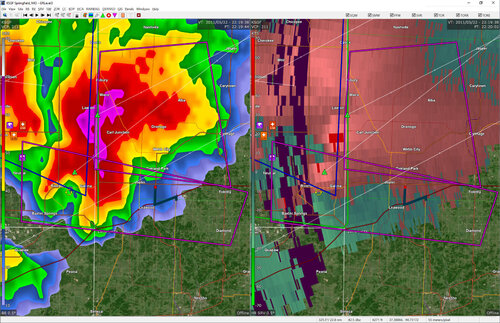
At 2219z a tornado warned supercell is depicted due west of Joplin. The warning, issued two minutes earlier, cites a radar indicated tornado and includes Joplin in the list of impacted areas. There's a cell merger ongoing at this time, but the indicated rotation is indeed the area of interest that goes on to produce the Joplin tornado. This warning is for what would become the Joplin EF5.
The storm that produced the Joplin tornado was not yet warned at the time and given the lack of updated radar did not yet display a violently tornadic couplet.
So this scan was after the gas station stop then? There was 20+ minutes between the stop at the gas station and escaping south on Range Line Road? Or you guys had no data and were unaware this was happening for 20 minutes? Or you were only considering the "undercut" tornado warning to the north over Carl Junction and Webb City? Where was the tour at this time? Did you guys see this scan and warning? Because it looks like you didn't, or you wrote it off. Although the tornado warning text cited a northeast moving tornado, the polygon suggested storm motion east-southeast. The prior warnings cited motion to the east. The watch cited storm motion to the east. So I'm leading a tour and carefully watching radar. Do I decide that this is a good time to unload three vans of tourists in a congested urban area to go candy shopping?
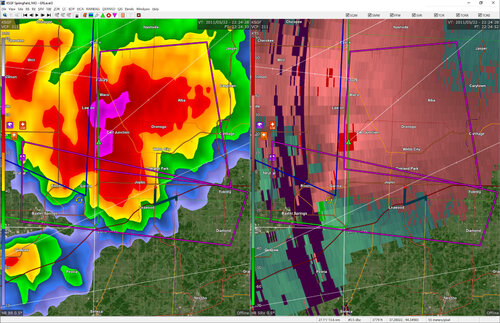
At 2224z the Conoco is north of the couplet. Did guys make it there yet?
Two more scans. At 2229z the merger is now a consolidated supercell. The warning is then updated, again citing a radar indicated tornado and reported funnel clouds moving east. A scan at 2234z and the Joplin tornado is underway.
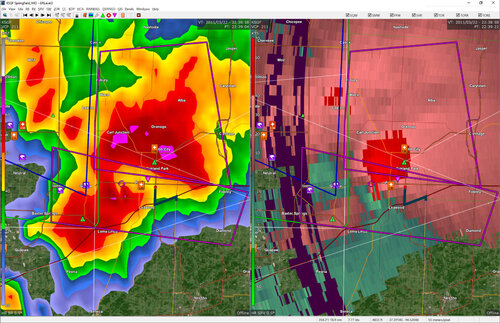
At 2238z the Conoco is north of the bulk of the couplet and most intense reflectivity echo in the hook ball. At this point you need to seriously consider what your best option is. Probably slightly north of the tornado, do you cut across the likely path, and then the huge RFD and flanking line core? I mean you're almost damned if you do, and damned if you don't at this point given the size and any possible deviation. I wish there were timestamps, but based on the videos, SLT may be just now starting to move south on Range Line Road.
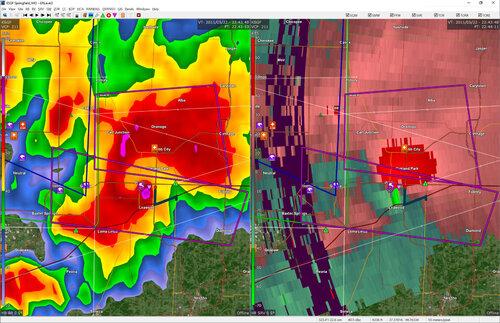
At 2243z SLT is likely southbound on Range Line Road, the tornado visible in clients' videos to their northwest. It's not like this thing came out of nowhere. A series of mistakes has to be made to be in this situation.
The decision to get on I-44 to get "ahead of the storm", implying that we were trying to chase it, is also incorrect.
That's not what I intended. It's obvious you guys were trying to escape. I'm trying to point out that these are ill conceived escape routes. There's this knee jerk reaction to cross the tornado's path to get to clear air. That was driven home for everyone after El Reno, but if you look back, there's a long history of these mistakes being made.
In that situation why on Earth would you pick the northern option?
And yet you wound up crossing the entirety of the mile wide damage path. Unknowingly one ensnarled intersection, one snickers bar away from death. That's what we're trying to fix here. Not drag SLT through the mud, but fix critical errors that are getting people hurt and killed.
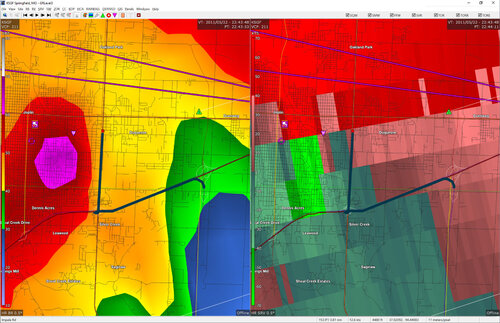
And the whole "TWICE" thing: In that situation you are chasing visually
Before or by the time you're hitting I-44,
all three vans correctly identified that the tornado was to their north or northwest, crossing behind them. You can hear this in discussions in the videos. I believe it was even you in the video from van 1 that says, "I think the tornado is right to our north". All three vans then proceed to head northeast on I-44 back toward the tornado's path. Yeah, the clear air is just ahead and you could make it. But it's three miles before the next exit. One Lone Star-Lawrence-esque tornado accelerating RFD surge, one blocked off ramp from death.
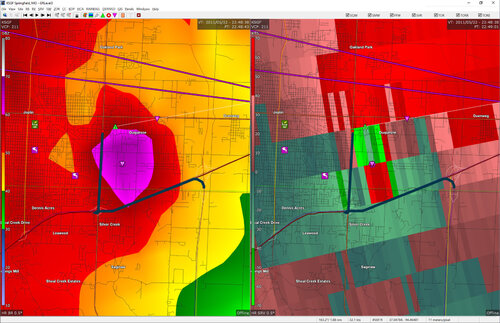
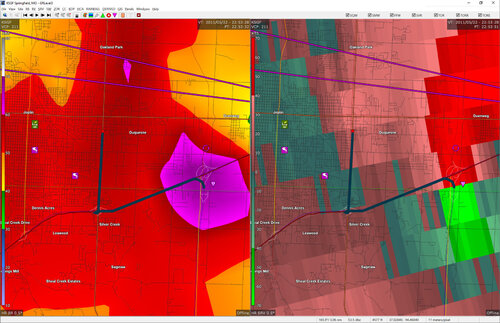
Could we potentially have made other decisions at Joplin? Maybe. Perhaps we could have gone north instead of south and chose to get crushed by the hail core in exchange for a shorter path out, who knows.
Not maybe. Definitely. It needs to be said over and over again, every season:
If you need to escape, always pick the loss of all glass from forward flank softballs over racing a tornado across its path. Guaranteed crushed by hail > possibly crushed by wedge.
It's a shame that Skip felt he needed to try and link the two to somehow reinforce his analysis of Lawrence, which apart from that erroneous linkage
We look at past events to better ourselves by identifying correctable and fatal mistakes that chasers are repeatedly making. The two biggest errors that we see over and over again, including on Joplin, 2011 El Reno, 2013 El Reno, and Lone Star/Lawrence:
- Chasing without situational awareness
We were not even really chasing
You take a pit stop mid-race, you're still racing. You take a break mid-chase in the middle of an active warning, with no visual reference, in an urban environment, and no well planned escape routes, that's fatal.
- Escaping across the tornado's path
Roger panicked. Chasing was still in its innocent days before chasers started getting killed by tornadoes. SLT should not be raked through the coals for Joplin, and that's not at all what I'm trying to do here. Please don't get me wrong. But these were critical mistakes that need to be carefully examined in hindsight so that we can have the foresight not to repeat them. SLT took a woefully late escape route, and then raced to cross the full width of Joplin's path, either because they misjudged the storm structure, misjudged the radar, or simply had no situational awareness from which to judge (see above). And then to visually clear the tornado, and turn back toward its path through blinding RFD on a limited-access road, that's fatal.
But we didn't learn from Joplin, and we didn't learn from El Reno, did we? These same lessons about not chasing blind, and racing tornadoes across their paths would have prevented the Lone Star incident. It's simply luck that there weren't rolled tour vans sooner.
Do you think I like being berated and despised by the people that I once looked up to as heroes and role models? But when there are literally lives on the line, it's morally reprehensible to not say something. And when authorities in this community try to defend the repeated flawed behavior that endangers others, maybe for the sake of ego, or pride, personal or professional liability, it is going to be called out. Every time. Roger and Jon are probably never going to read this, and this is probably not going to change the minds of any of SLT's defenders. This is for the rest of you out there that look up to these people for guidance and example, as I did.








